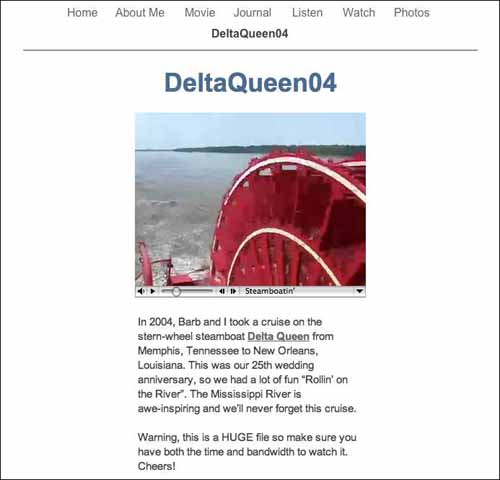Digital video is becoming much easier to produce, thanks to better camcorders and software like iMovie HD. You can share your digital videos with your Web site visitors by converting the videos to a Web-friendly, low-bandwidth format, then exporting them to iWeb. The process is extremely easy, once you’ve created the digital video.
Warning—first frames count!
The first frame of your movie will show on your iWeb movie page, so be sure to use an image for the first frame and not a blank black screen (do as I say, not as I do—my vacation video on the example site starts with a black screen).
Here’s how to publish your movie:
With your edited movie open in iMovie HD, choose Share > iWeb.
Select a format for your movie:
If you think your file will be less than 10 MB in size after compression, use “Share for Podcast” since it produces a much better looking video.
Otherwise, use “Share for Web.”
When you’ve chosen a format, click Share.
iMovie HD compresses and formats your movie with the proper size, frame rate, and audio quality. This process can be very time-consuming. I converted a movie of a vacation for publishing in my example Web site; the 31-minute movie took about 4 hours to convert. You can see the results by viewing the movie DeltaQueen04 on the example Web site. Since it is such a large movie (43 MB), I used the lower-quality video setting.
Once the conversion is complete, iWeb will prompt you for the Movie page template you would like to use. It’s a good idea to remain consistent with the rest of the pages used on your Web site. Click the template name in the Template Chooser, click the corresponding Movie page template, and finally click Choose.
The page will be created for you, featuring your video creation.
Select and edit the headline and the descriptive text for the Movie page. You can also add a shadow to the picture on the movie page using the Graphic Inspector (see The Fine Points of Formatting Photos). I wish there were a way to add a frame to the picture, but that’s probably in the works as an improvement for a future version of iWeb.
You’ve now successfully added a movie to your iWeb site. Figure 55 shows my Movie page as it appears in a Web browser.
Note: Video for Windows Users
iMovie HD usually creates video with H.264 encoding technology. Many Windows users have upgraded to QuickTime 7 or similar software that can decode H.264 video, but if they haven’t they won’t be able to view your movies.
To make sure they can view your movies, consider linking to the latest version of Windows QuickTime from your Movie page—http://www.apple.com/quicktime/download/standalone.html.
If Windows users can’t upgrade to the latest version of Quick Time or another player application that can decode H.264 video, you should choose a different method of encoding your video, such as MPEG-4. Depending on what application you’re using to encode your video, you should be able to find settings for the codec (software used to encode and decode video) by choosing a Save As, Share, or Export menu item.

